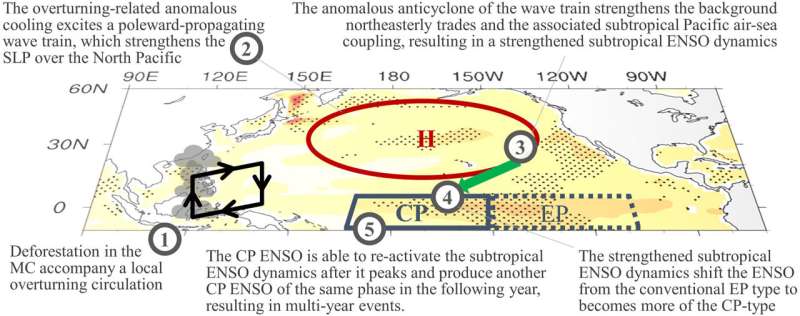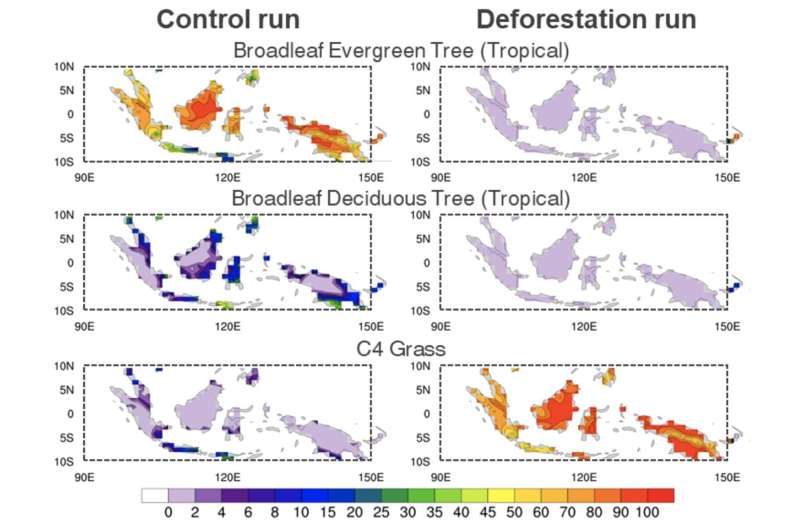November 7, 2023 feature
This article has been reviewed according to Science X's editorial process and policies. Editors have highlighted the following attributes while ensuring the content's credibility:
fact-checked
peer-reviewed publication
trusted source
proofread
Deforestation across the 'Maritime Continent' is making El Niño-Southern Oscillation more unpredictable, finds study

El Niño-Southern Oscillation (ENSO) is a climate phenomenon occurring every 2–7 years in the tropical Pacific Ocean, associated with changes in air pressure east to west.
During El Niño events equatorial trade winds blowing west weaken, causing changes in air pressure and wind speed that move warm surface water eastward from the western Pacific to coastal South America. This results in a deeper thermocline (the depth at which sea temperature rapidly changes) that prevents the normal upwelling of cooler, nutrient-rich waters, having devastating impacts on marine food chains, as well as local communities reliant upon the fishing industry.
It also brings heavier and prolonged rainfall to South America, increasing the threat of flooding, while in Australia and Indonesia there is drought, posing hazards for water supply and irrigation for agriculture. During La Niña events, all off these conditions reverse.
New research published in Geophysical Research Letters suggests that ENSO is likely to be strongly impacted by continental deforestation (purposeful felling trees), specifically that occurring in the "Maritime Continent"—the region between the Indian and Pacific Oceans that includes the archipelagos of Indonesia, Borneo, New Guinea, Philippine Islands and Malay Peninsula.
Land use changes such as deforestation reduce evapotranspiration and cause alterations to surface albedo (the amount of sunlight reflected by Earth's surface) that ultimately warms the ambient environment. This further impacts land-atmosphere-ocean interactions to modify local climate.
Dr. Ting-Hui Lee, from the University of California, and colleagues used the Community Earth System Model to simulate hypothetical future deforestation over 100 years, changing the native broadleaf evergreen and deciduous trees to C4 grass. Such activity was found to strengthen ENSO, resulting in increased frequency of events and a shift towards the central Pacific. This occurs via the seasonal footprinting mechanism, whereby mid-latitude sea surface temperatures in winter affect the subtropical atmosphere the following spring and summer.

Conversely, descending air pressure over the tropical western Pacific suppresses atmospheric convection with anomalous temperature contrasts between land and sea. The latter cools and propagates colder water polewards by a process known as a Rossby wave train. This results in a positive shift in sea level pressure over the subtropical northeastern Pacific, which when combined with an atmospheric pressure high in boreal winter (December-February) results in stronger ENSO events.
The subtropical north Pacific atmospheric pressure high reactivates the seasonal footprinting mechanism and causes La Niña conditions to occur for multiple concurrent years, instead of the normal switching with El Niño alternate years. The research team propose that more of these multi-year La Niña events are likely to occur in the decades to come if deforestation continues, with the simulations suggesting a 13.8% increase. This has already been exemplified by three multi-year La Niña's in the 21st century: 2010–2012, 2016–2018 and 2020–2022.
Additionally, the transition of ENSO-like events to the central Pacific may be explained by a positive shift in trade winds in the northeastern Pacific, which increases localized wind speeds and therefore the cooling of the surface ocean.
The likelihood of El Niño events occurring increased 11.7% as a result of deforestation compared to background levels in the models, while La Niña events were exacerbated 14.6% in the same simulations with the significant removal of trees.
While further work is required to understand the effects of deforestation in real time compared to purely modeling them, the suggestion of changing ENSO dynamics to more frequent multi-year events poses issues for predictability and therefore communities mitigating against their impacts.
More information: Ting‐Hui Lee et al, The Potential Influence of Maritime Continent Deforestation on El Niño‐Southern Oscillation: Insights From Idealized Modeling Experiments, Geophysical Research Letters (2023). DOI: 10.1029/2023GL105012
Journal information: Geophysical Research Letters
© 2023 Science X Network




















